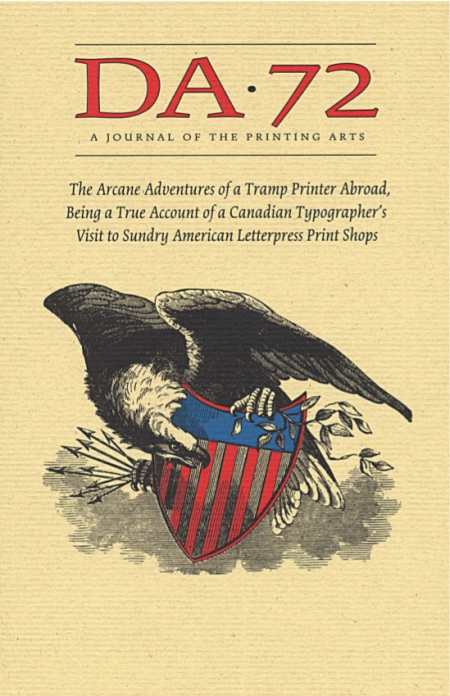
The Devil's Artisan 72
A Journal of the Printing Arts
This travelogue through small presses shows that the art of printing remains alive even in a digital world.
Andrew Steeves’ recounting of a three-week whirlwind tour of small print shops in Canada and the United States highlights the accomplishments of small presses like his own in Nova Scotia: their equipment, their history, and the minds behind them.
“We have to cultivate a community that will support us in our work while we support and nurture it by producing quality books,” writes Steeves, co-founder of Gaspereau Press and author of The Arcane Adventures of a Tramp Printer Abroad, Being a True Account of a Canadian Typographer’s Visit to Sundry American Letterpress Print Shops, the featured article in Issue 72 (Spring/Summer, 2013) of DA (Devil’s Artisan). This small semi-annual Canadian monograph edited by Don McLeod prides itself in the fact that “most of the physical production of our journal is completed in-house at the shop on the Main Street of Erin Village.”
Small presses are often, like Gaspereau, family-run, keeping alive the honorable tradition of producing printed matter that is not merely informative, but also visually and tactilely satisfying. Books, in a word—products that are possibly going out of style. In fact, Steeves fairly reports on the rants of former printer Michael Russem, who opines that small presses don’t “meet the expectations of the modern reader.”
But where Steeves traveled in autumn 2012, he encountered enthusiastic practitioners of his art: in Nashville, where the secret of poster making with antique equipment is alive and thriving at Hatch Show Print; at Amos Paul Kennedy’s print shop in Gordo, Alabama; in Denmark, Iowa, where he attended a workshop at Larry Reid’s Linotype University (“a little too relaxed and disjointed,” he remarks in retrospect).
His “arcane adventures” are also a travelogue, as he believably battles driver burnout, time-zone confusion, and the wonders of sleeping in a different bed almost every night, from cheap motels to a basement bedroom shared with a huge aquarium. He samples barbecue, spends an evening with legendary philosopher Wendell Berry, goes to a youth rodeo, and takes breakfast in Hannibal “in honour of Mark Twain.” Steeves has appended a list of links to the presses he visited.
In addition to Steeves’ story, Issue 72 also contains a short article by George A. Walker with hand-engraved woodblock prints from his “wordless narrative” about publisher and convicted white-collar criminal Conrad Black. There is a one-page piece by Steeves about printer Thaddeus Holownia, and a contribution by Richard Kegler concerning the revival of the Athena typeface. In every way, the DA experience lives in the DA journal, offering its readers both sensory enjoyment and intellectual stimulation: what is read is part of what is seen and held. Like many crafts, hand printing reminds us of what we are losing or have already lost.
Devil’s Artisan is written for, by, and about traditional printers, with much in-house technical data, but if this issue is typical, there is plenty of intellectual sustenance for an interested outsider. Steeves’ saga evokes as many questions as answers about the possible future of the art of small press printing; he concludes, “It is a conversation I am looking forward to continuing in the years to come.”
Reviewed by
Barbara Bamberger Scott
Disclosure: This article is not an endorsement, but a review. The publisher of this book provided free copies of the book and paid a small fee to have their book reviewed by a professional reviewer. Foreword Reviews and Clarion Reviews make no guarantee that the publisher will receive a positive review. Foreword Magazine, Inc. is disclosing this in accordance with the Federal Trade Commission’s 16 CFR, Part 255.
